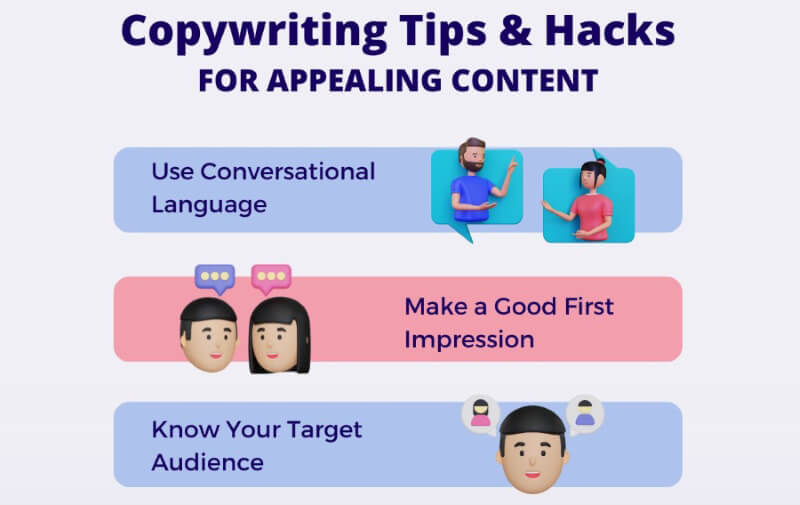11 Copywriting Tips & Hacks for Appealing Content

Ever wonder about the difference between quality content, and the sorts of blogs you can’t help but share on your personal Facebook page? The research and depth behind content matter, and so do the originality of your ideas. However, what about the other elements? Can you define the x-factor behind blogs which feel like a conversation with a best friend, and the ones that put you to sleep?
The definition of effective copywriting hacks can vary widely according to target audience; what works well for a reader of Harvard Business Review won’t resonate with someone who prefers USA Today. However, some of the world’s best-known bloggers have mastered the art of writing conversationally.
Are you unconvinced that there’s a connection between conversational writing, and copy that’s appealing? A Journal of Educational Psychology study found that less-technical text was clearly tied to 20-46% higher retention among students. Simple is likeable. Explore these copywriting tips and hacks to boost the likeability of your content marketing going forward:
1. Stop Trying to Sound Smart
Few things are more divisive to everyone than an article that comes across as pretentious. Master content marketer Marcus Sheridan’s broken down the issue with content marketers trying to sound intelligent: the most important goal should be that your reader “knows what the heck you’re talking about.” For most companies, that means writing simply, and removing any “five dollar words.” Impress people with your research, expertise and copywriting tips and hacks, but avoid any language that your readers need a dictionary to understand.
2. Take Out Extraneous Words
Be honest with yourself here. Which of the following sentences makes your eyes cross, and which inspires you to action?
There’s too much content online to get away with poor quality.
or
The abundance of fresh copy published to the web on a daily basis has necessitated an increasing commitment to quality for the majority of inbound marketing-focused companies.
See the point? If you can say it more simply, cut the extra words and let statistics and expert quotations do the talking. Novelist Heidi Thomas recommends considering the following copywriting tips to keep your work as pithy as possible:
- Remove Pleonasms: I know we’ve already covered the problem with long words, but a pleonasm is a word which can be removed from a sentence without changing the meaning. Think “I sat down” versus “I sat.” In this case, down is a pleonasm.
- Axe Words Without Meaning: There are words which have been overused to the point of losing their meaning in many contexts. Examples include “unique,” “very” and perhaps even “quality.”
- Use Better Verbs: If you’re engaged in brand storytelling, using stronger verbs could allow you to cut your word count significantly. Thomas points to case where someone “walking quickly” could be simply replaced with “strode.”
3. Develop Your Own Style
Unless your company’s buyer persona is a Professor or a Journalist, you can pretty much burn your APA style guide. Many of the world’s most-beloved business blog personalities are just that – real people who’ve branded themselves with their content. Think of HubSpot’s Pamela Vaughan, whose writing could be described as “warm and helpful.” Or Marcus Sheridan of The Sales Lion, who writes extremely accessible (but slightly sassy) content. Louis Allport wisely points out that writing in your own style can help even the most academic writers shake the staid style which works in a university setting, but tends to fall flat on a contemporary blog.
4. Follow the 16-Word Rule
If you’re one of those writers who cling to rules, consider the following among your copywriting tips and hacks. Never write a sentence that’s longer than 16 words. If you do, break it in two or remove pleonasms. As pro copywriter E.T. Robbins says “Less is more. Really.”
5. Don’t Be Stilted
There’s an obvious relationship between the words “stilted” and “stilts.” Think about the connection. Stilts are unnatural and potentially uncomfortable extensions. If any of your language is unnaturally elevating your message, give it a heavy-handed edit. If you’re unsure what qualifies as stilted, check out this ironic example from the Writing Excuses blog:
“‘We mustn’t forget to include adverbs’ said Dan pensively.”
Isn’t that just awkward to read? Stilted writing happens to experienced and powerful marketers, especially when they’re forcing themselves to meet a deadline. However, the most effective copywriting tips you learn today could be learning to look for it, and edit it promptly.
6. Make Your Message Clear
David Ogilvy, one of the most famous advertising professionals of all times, remains a well-known source for copywriting tips and hacks. His recommendation? “Make sure it is crystal clear what you want the recipient to do.” Whether you’re the sole content marketer and responsible for editing your own work or on a large team, be sure your editing process looks for clarity in your call-to-actions.
For more on copywriting hacks for penning a call-to-action that converts, check out Top Writing Tips to Infuse Your Blog with Stickiness.
7. Don’t Force It
There are a few situations that are pretty-much guaranteed to result in unappealing content:
- You have no idea what you’re talking about, and no time to research.
- You’re not sure what the point of the blog is, but you’re almost at your goal word count.
- You’re really just trying to optimize around a very important search keyword.
While the jury is still out on whether or not you can surmount writer’s block, never start typing without a clear end result in mind. Your messaging might change mid-way through, but be sure to carefully edit for clarity. No amount of short sentences, italicized text, or copywriting tips and hacks can increase the appeal of a blog that’s just pointless.
8. Get to Know Active Verbs

Very few people love corporate-sounding language. There’s a time and a place for very technical jargon, but it probably isn’t on your company’s blog. Lifehack’s contributing editor Dustin Wax has stated that essential copywriting tip for avoiding terribly corporate language is learning to embrace active verbs. Check out his example below:
“Our company leads in the manufacture of robots.”
or
“Our company is a leading manufacturer of robots.”
Doesn’t the first sentence sound so much more active and intriguing? Your toolbox of copywriting tips and hacks should include a strong vocabulary of active verbs, and the ability to incorporate them.
9. Stop Justifying Yourself
Truly appealing content inspires action and conviction in the reader. In order to achieve this end goal, you’ve got to stop apologizing for your position. The problem with statements like “I believe,” “I think,” and “I intend to” is not just that they add extra words to your content marketing. In some cases, they could diminish your authority and make it seem like you’re justifying yourself.
Don’t tell the reader that you think something. Tell them what you think, and include some fresh statistics or studies to drive your point home. Learning to remove the term “I believe” from your writing is a huge step towards writing conversationally. It’s also a pretty awesome copywriting hack for conveying expertise.
10. Don’t Be Too Subtle
The majority of connected consumers leave a web page in just 10-20 seconds. That isn’t very long at all. Certainly not long enough for your super-subtle turn of phrase or pop culture reference to sink in, anyway.
If your business’s online voice can include humor, go big. Write an amusing headline, create a custom meme, or start off your blog with a cheesy joke. Don’t bury your subtle turn of phrase in a long paragraph and expect it will get found. The vast majority of your website visitors will simply skim past it. One of the best copywriting tips to increase appeal is to just say no to being subtle.
11. Appeal to Literally Everyone
It’s true that your content shouldn’t appeal to everyone. If you’re blogging for business, trying to achieve truly mass appeal will probably result in basic, bland articles. However, you definitely should accommodate three distinct segments within your ideal audience, defined by Rich Gorman as follows:
- True Readers: Your audience who faithfully absorb every word.
- Not Really Readers at All: Individuals who check out your visual content and captions, and then bounce.
- Skimmers: The largest segment by far, who check out section headers, and delve into paragraphs which seem most interesting and helpful.
Your challenge in achieving the elusive goal of mass appeal is to adopt the copywriting hack of appealing to all three segments. Curate or customize visual content that conveys your target message and carefully section your writing into bullet points and numbered lists. Finally take the time to edit well enough that even your most dedicated readers won’t notice a single flaw.
And what should you do if all of the above copywriting tips and hacks aren’t effective at helping you create content with a broader appeal? Shut your laptop, and record yourself talking about a subject you’re really passionate about, and let yourself hear the difference. The world’s most brilliant content marketers don’t have a special degree from a super-secret academy; they’re just able to effectively capture their energy, passion, and tone for the web with copywriting tips.
Which copywriting tips and hacks have helped you write more appealing content marketing?

Comments (0)